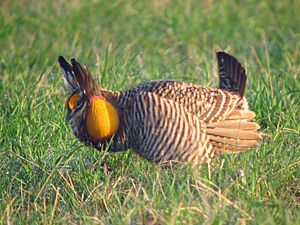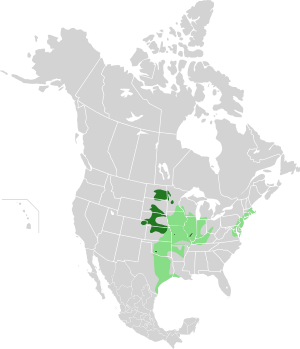Greater prairie chicken facts for kids
Quick facts for kids Greater prairie chicken |
|
|---|---|
 |
|
| Male displaying in Illinois, USA | |
| Conservation status | |
| Scientific classification | |
| Genus: |
Tympanuchus
|
| Species: |
cupido
|
| Subspecies | |
|
Tympanuchus cupido attwateri |
|
 |
|
| Distribution map of the Greater Prairie-Chicken. Pale and dark green: pre-settlement Dark green: current year-round |
|
| Synonyms | |
|
Tetrao cupido Linnaeus, 1758 |
|
The greater prairie chicken (Tympanuchus cupido), also known as a boomer, is a large bird in the grouse family. These birds live in North America. They used to be very common across the central grasslands. However, because their habitat has been destroyed, there are now very few left in some areas. In other places where they once lived, they are completely gone. People are working hard to protect the remaining prairie chickens.
Adult greater prairie chickens are medium to large birds. They look a bit like chickens. They have round wings and short tails. Both males and females have a barred pattern of brown and white feathers.
Contents
Where do Greater Prairie Chickens Live?
Greater prairie chickens prefer to live in wide, open prairies and grasslands. These areas have tall grasses and wildflowers. They need these spaces for nesting, finding food, and hiding from predators. They also need areas with scattered shrubs and trees.
What is their Habitat Like?
Their ideal home is a mix of tall-grass prairies and areas with some shorter plants. They use the tall grass to hide their nests and young chicks. Shorter areas are good for finding insects and seeds to eat. They avoid areas with many trees or buildings.
What do Greater Prairie Chickens Eat?
Greater prairie chickens are omnivores, meaning they eat both plants and animals. Their diet changes with the seasons.
Seasonal Diet
In the spring and summer, they mostly eat insects like grasshoppers and crickets. They also enjoy fresh green plants and berries. In the fall and winter, their diet shifts to seeds, grains, and buds from plants. They might also eat leftover crops from farm fields.
Life Cycle and Reproduction
The life cycle of the greater prairie chicken is quite interesting, especially their unique mating ritual.
The Booming Dance
In the spring, male prairie chickens gather in special open areas called "leks" or "booming grounds." Here, they perform a loud and colorful display to attract females. They inflate bright orange air sacs on their necks, make a deep "booming" sound, and stomp their feet. They also fan their tail feathers and strut around, sometimes fighting with other males. This dance is how they show off to the females.
Nesting and Chicks
After mating, the female builds a nest on the ground. She usually hides it well among tall grasses. She lays about 10 to 12 eggs. The eggs hatch after about 23 to 26 days. The chicks are able to walk and find food soon after hatching. The mother prairie chicken takes care of them, teaching them how to find food and avoid danger. The young birds grow quickly and are ready to fly within a few weeks.
Why are Greater Prairie Chickens Endangered?
The number of greater prairie chickens has dropped a lot over the years. They are now considered a vulnerable species.
Loss of Habitat
The biggest reason for their decline is the loss of their grassland habitat. Prairies have been turned into farms, towns, and cities. This leaves less space for the birds to live, nest, and find food. As their habitat shrinks, it becomes harder for them to survive and reproduce.
Other Threats
Other threats include pesticides used in farming, which can harm the insects they eat. Also, predators like foxes and hawks can easily find them when their hiding places are gone. Changes in the climate can also affect their food sources and nesting success.
Conservation Efforts
Many people and groups are working to save the greater prairie chicken.
Protecting and Restoring Prairies
One important effort is to protect the remaining prairies. This means setting aside land where the birds can live without disturbance. People are also working to restore prairies that have been damaged. They plant native grasses and wildflowers to bring back the natural habitat.
Breeding Programs
Sometimes, scientists try to breed prairie chickens in special facilities. The goal is to release these birds back into the wild to increase their numbers. These efforts help to ensure that future generations can still see these amazing birds.
See also
 In Spanish: Gallo de las praderas grande para niños
In Spanish: Gallo de las praderas grande para niños


